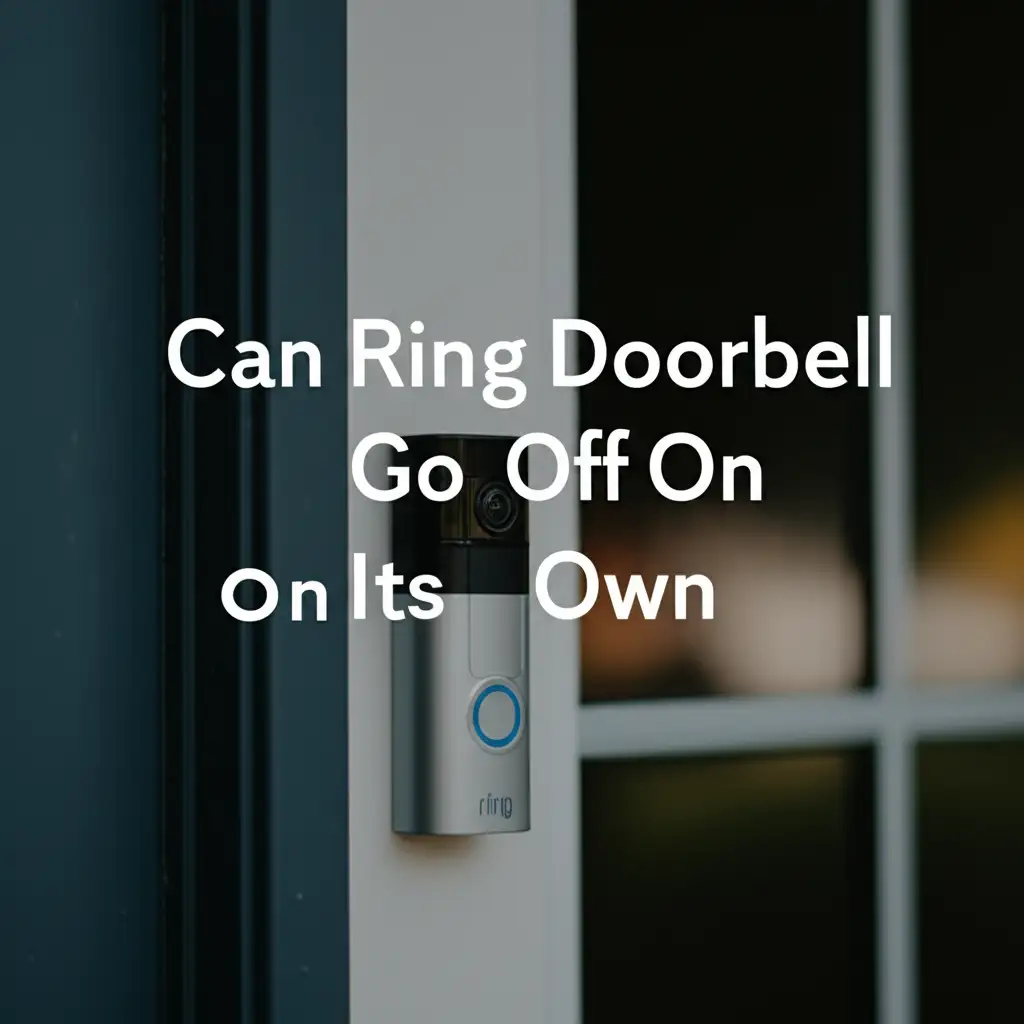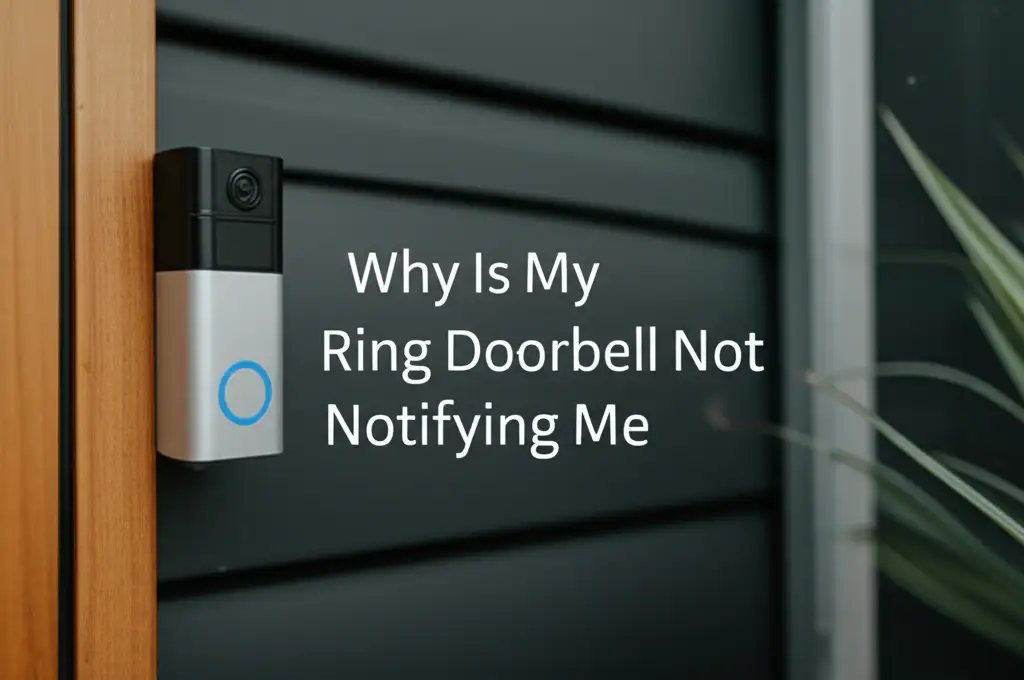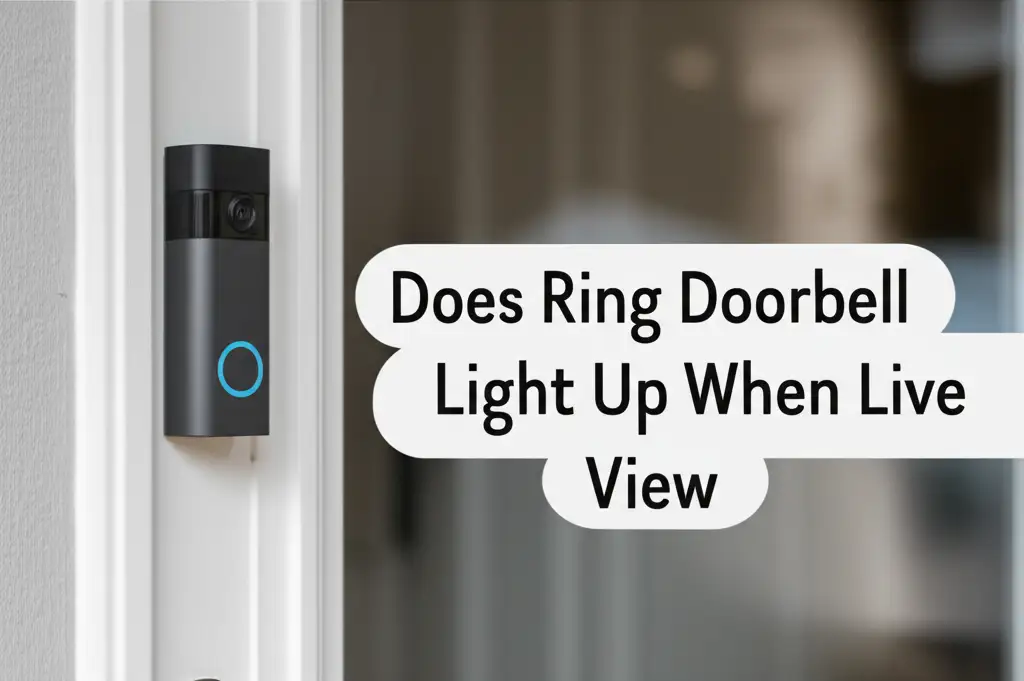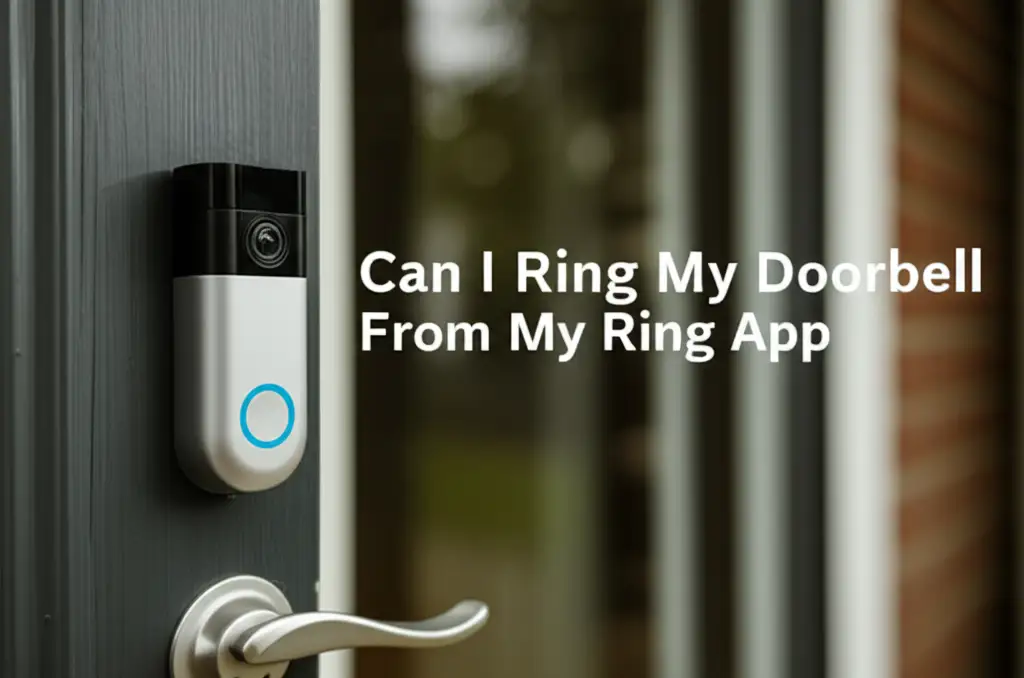· Katria Melrose · Smart Home Security · 19 min read
Can Ring Doorbell Go Off On Its Own

Can Ring Doorbell Go Off On Its Own? Understanding Unexpected Alerts
Have you ever wondered, “Can my Ring doorbell go off on its own?” You might be hearing phantom rings or getting notifications without clear reasons. It can feel a bit unsettling when your security device seems to have a mind of its own. I understand your concern. My own Ring doorbell has sometimes sent alerts that left me scratching my head.
This guide explores the common reasons why a Ring doorbell might seem to activate unexpectedly. We will look at factors from motion settings to network problems. Understanding these causes helps you fix unwanted alerts. By the end, you will know how to manage your device better. This article offers clear steps to ensure your Ring doorbell works correctly.
Takeaway
- Adjust Motion Settings: Fine-tune motion zones and sensitivity to reduce false alerts from pets, cars, or weather.
- Check Wi-Fi Connection: A strong and stable Wi-Fi signal is important for proper function.
- Inspect Power Source: Ensure consistent power; low battery or unstable power can cause odd behavior.
- Update Firmware: Keep your Ring device’s software current for optimal performance and bug fixes.
- Review Event History: Use the Ring app to review recordings and understand why alerts occur.
Clear Answer to the Main Query
Yes, a Ring doorbell can appear to go off on its own, but it is typically not a random malfunction. Instead, unexpected activations usually happen due to specific settings, environmental factors, or connectivity issues. It rarely means the device is truly “malfunctioning” without a cause.
How Ring Doorbells Detect Activity
Ring doorbells are smart security devices. They use sensors to detect activity near your door. Understanding these sensors helps explain why a Ring doorbell can go off on its own. The primary ways a Ring doorbell senses activity are motion detection and button presses.
Motion detection uses infrared sensors or camera analysis. Infrared sensors detect heat changes from moving objects. Camera analysis looks for changes in pixels within the video frame. When the doorbell button is pressed, it sends a direct signal. These triggers initiate recordings and send notifications to your phone. The system is designed to keep you informed about visitors or anything moving on your property. This technology aims to make your home more secure.
Your Ring app shows you these events. You get alerts on your phone or tablet. The device also lights up when it detects motion. This visual cue tells people it is working. The camera starts recording when a trigger occurs. This recording helps you see what caused the alert. Knowing how these triggers work is the first step to managing alerts.
Common Reasons for Ring Doorbell False Alarms
It can be annoying when your Ring doorbell sends alerts for no clear reason. These “false alarms” make it seem like the doorbell is going off on its own. However, there are common culprits behind these unexpected notifications. Most often, the cause lies in how the motion detection system is set up or what is happening in the environment. My Ring doorbell used to alert me every time a car passed, until I understood these reasons.
One major reason is motion sensitivity. Ring doorbells let you adjust how sensitive they are to movement. If sensitivity is too high, small things can trigger an alert. This includes pets, small animals, or even distant objects. The doorbell senses motion and thinks it is an important event. This leads to many unnecessary notifications.
Environmental factors also play a big role. Sunlight glare can sometimes mimic movement. Bright light hitting the lens directly can cause the sensor to react. Shadows moving across your property also trick the system. A tree branch swaying in the wind can cast moving shadows. This looks like motion to your doorbell. Heavy rain or snow can also appear as motion. Water droplets moving quickly across the lens can trigger alerts. Even insects flying close to the camera lens can cause an alert. They look like large objects to the camera, especially at night when the infrared lights are on.
- High Motion Sensitivity: The doorbell reacts to minor movements.
- Direct Sunlight/Glare: Bright light tricks the sensor.
- Moving Shadows: Shifting shadows mimic movement.
- Weather Conditions: Rain, snow, or strong winds can cause alerts.
- Insects Near Lens: Bugs flying close to the camera appear as motion.
These elements are common reasons for unexpected activations. Adjusting your settings can help reduce these unwanted alerts. Remember, your doorbell is trying to do its job. It just needs a little help to focus on what matters. It is like training a guard dog; you want it to alert you to real threats, not every squirrel.
Optimizing Motion Detection Settings
Adjusting your Ring doorbell’s motion detection settings is important. This helps reduce false alarms. You can make your doorbell smart about what it sees. I found that fine-tuning these settings greatly improved my experience. It stopped my doorbell from sending alerts for every passing car.
First, consider motion zones. Ring allows you to define specific areas the doorbell should monitor. You can draw these zones in the Ring app. For example, you can exclude busy streets or neighbors’ walkways. Focus the zones on your porch or pathway to your door. This ensures the doorbell only alerts you to activity in relevant areas. This feature is very helpful for busy locations.
Next, adjust motion sensitivity. This controls how much movement is needed to trigger an alert. You can lower the sensitivity if you get too many alerts. This makes the doorbell ignore minor movements. A squirrel running across the yard might not trigger it anymore. Raising sensitivity means it will detect even slight movements. Find a balance that works for your home.
Ring also offers Smart Alerts or People Only Mode. This setting helps the doorbell differentiate between people and other things. When enabled, your doorbell tries to detect only human shapes. This can drastically cut down on alerts from pets or passing vehicles. It uses a different analysis to determine if the detected motion is truly a person. This feature requires a Ring Protect plan. Many users find it makes a big difference.
- Define Motion Zones: Exclude irrelevant areas like roads or neighbor’s property.
- Adjust Motion Sensitivity: Lower it to ignore minor movements like swaying branches or small animals.
- Enable Smart Alerts/People Only Mode: Focus alerts on human detection to reduce non-human triggers. This often needs a subscription.
- Review Motion Settings Regularly: Environment changes can affect performance; adjust settings as needed.
- Utilize Privacy Zones: These areas are blacked out and not recorded, helping protect privacy while also preventing triggers from those areas.
Properly configured settings ensure your Ring doorbell works for you. It helps you get alerts that truly matter. For more details on what notifications you might get, you can check if your Ring doorbell only rings on your phone. Adjusting these settings can make your security system more effective and less intrusive.
Wi-Fi Connectivity and Signal Issues
A strong and stable Wi-Fi connection is crucial for your Ring doorbell. If your doorbell seems to go off on its own, a poor Wi-Fi signal might be the reason. I learned this the hard way when my doorbell started acting erratically. It would sometimes miss events or send delayed notifications. These issues often stem from an unreliable network connection.
Ring doorbells rely on Wi-Fi to send data to the cloud and communicate with your app. When the signal is weak or unstable, the doorbell struggles to maintain this connection. This can lead to various problems. For example, the doorbell might try to reconnect repeatedly. Each reconnection attempt can sometimes trigger a false “event” or lead to strange behavior. The device might momentarily lose power, then reconnect, causing a brief recording.
Interference can also impact your Wi-Fi signal. Other devices using the same frequency, like cordless phones or microwaves, can disrupt the signal. Physical obstructions, such as thick walls or metal objects, weaken the signal strength between your doorbell and router. The further your doorbell is from your router, the weaker the signal will be.
- Weak Signal: The doorbell struggles to connect, causing delays or lost events.
- Signal Interference: Other devices or physical barriers block the Wi-Fi signal.
- Router Distance: Being too far from the router weakens the connection significantly.
- Network Congestion: Too many devices on the same Wi-Fi network can slow it down.
You can check your Ring doorbell’s Wi-Fi signal strength in the Ring app. It shows as RSSI (Received Signal Strength Indicator) values. A lower negative number (e.g., -40) is better than a higher negative number (e.g., -70). If your RSSI is high, you might need to move your router closer. You could also install a Wi-Fi extender. Improving your Wi-Fi signal ensures smooth operation. It helps prevent those puzzling, self-triggered alerts. A reliable connection means your Ring doorbell communicates effectively.
Power Supply and Battery Performance
The power source plays a significant role in how your Ring doorbell performs. Issues with power can certainly make it seem like your Ring doorbell goes off on its own. Whether your doorbell is battery-powered or hardwired, inconsistent power can lead to unexpected behavior. I once had a battery issue that caused my doorbell to act strangely until I charged it fully.
For battery-powered Ring doorbells, a low battery is a common culprit. When the battery gets too low, the doorbell might struggle to function correctly. It could send partial recordings or ghost notifications as it tries to operate on insufficient power. It might also disconnect and reconnect to Wi-Fi more often. Each time it reconnects, it might trigger a brief event. Keeping your battery charged is very important for consistent performance. You want to know how to know if your Ring doorbell is fully charged to avoid these issues.
Hardwired Ring doorbells also need a stable power supply. They connect to your home’s existing doorbell wiring. If the transformer is not powerful enough or is faulty, the doorbell might not get sufficient voltage. This can cause the device to reboot randomly or operate inconsistently. This instability can mimic random activations. Similarly, a loose wire connection can interrupt the power flow. Even a brief power interruption can cause the doorbell to reset. This might generate an alert when it comes back online.
- Low Battery (Battery Models): Insufficient power leads to erratic behavior, including phantom alerts.
- Inadequate Transformer (Hardwired Models): Not enough voltage causes reboots or inconsistent operation.
- Loose Wiring: Intermittent power supply results in restarts and false triggers.
- Power Fluctuations: Spikes or drops in electricity can disrupt normal function.
Regularly check your doorbell’s battery status in the Ring app. For hardwired units, ensure your transformer meets the doorbell’s power requirements. You can also inspect the wiring connections. A stable power supply helps your Ring doorbell work as expected. It helps prevent those puzzling moments when your doorbell seems to activate without cause.
Software Glitches and Firmware Updates
Sometimes, a Ring doorbell might seem to go off on its own due to software issues. These are often small glitches or bugs in the device’s operating system. Just like your phone or computer, Ring doorbells run on software. This software needs to be current and stable. I have seen minor software bugs cause strange behavior in many smart devices, including my own Ring.
Ring regularly releases firmware updates. These updates fix known bugs. They also improve performance and add new features. If your doorbell is running old firmware, it might have unresolved issues. These issues could cause it to misinterpret sensor data. This misinterpretation can lead to false motion alerts or phantom rings. Outdated firmware might also affect how the doorbell connects to your Wi-Fi network. This can create further instability.
It is important to keep your doorbell’s firmware updated. Ring doorbells typically update automatically when connected to Wi-Fi. However, sometimes an update might fail or be delayed. You can check your device’s firmware version in the Ring app. If an update is available, install it. A manual restart of the device (power cycling) can sometimes help force an update.
- Outdated Firmware: Older software versions may contain bugs that cause unexpected behavior.
- Software Glitches: Temporary errors in the device’s programming can lead to false alerts.
- Failed Updates: An incomplete firmware update can corrupt the system.
Troubleshooting Steps for Software Issues:
- Check for Updates: Open the Ring app and navigate to your device settings. See if a firmware update is available.
- Restart Your Device: Temporarily disconnect power for battery devices or flip the breaker for hardwired units. Wait a few seconds, then restore power. This can clear temporary software glitches.
- Re-establish Wi-Fi Connection: Sometimes, reconnecting to your Wi-Fi network can resolve communication errors that mimic software problems.
Keeping your Ring doorbell’s software current is a simple but effective maintenance step. It ensures your device operates with the latest improvements and bug fixes. This helps reduce the chances of your Ring doorbell going off on its own due to internal software problems.
Investigating Potential Hacking or Tampering
While less common, it is worth considering if your Ring doorbell’s unexpected activations are due to external interference. Could your Ring doorbell go off on its own because someone is messing with it? It’s a valid concern. Understanding the signs and knowing what to do is important for your security. I always advise people to be aware of potential threats to their smart home devices.
Hacking involves unauthorized access to your Ring account or device. If someone gains access, they could manipulate your doorbell. They might activate Live View, download recordings, or even trigger the chime. This could make it seem like the doorbell is going off by itself. Strong passwords and two-factor authentication greatly reduce this risk. Signs of hacking include activity you do not recognize in your event history. You might also find settings changed without your knowledge. It’s unsettling to think about, but staying vigilant helps protect your privacy and security. If you suspect this, you need to know how to tell if your Ring doorbell has been hacked.
Tampering refers to someone physically interfering with your doorbell. This could be someone trying to disable it or even trying to steal it. If the doorbell is tampered with, it might experience power interruptions or sensor damage. This damage could cause random alerts or make the device unresponsive. Physical damage can disrupt internal components, leading to unpredictable behavior. For example, if someone tries to pry it off, it might register as a sudden movement or impact.
- Unauthorized Account Activity: Check your Ring app’s event history for unrecognized logins or recordings.
- Changed Settings: Look for changes in your motion zones or notification preferences that you did not make.
- Physical Damage: Inspect the doorbell unit for signs of forced entry or damage.
- Loose Mounting: If the doorbell is loose, movement might trigger it.
To protect against these risks:
- Use Strong, Unique Passwords: Avoid common passwords and re-using passwords across different accounts.
- Enable Two-Factor Authentication (2FA): This adds an extra layer of security, requiring a code from your phone to log in.
- Monitor Event History: Regularly review the event log in your Ring app for anything unusual.
- Secure Mounting: Ensure your doorbell is securely installed to prevent physical tampering.
While rare, considering hacking or tampering helps ensure comprehensive security. Your vigilance is key to a safe smart home.
Troubleshooting Steps for Unexpected Alerts
When your Ring doorbell goes off on its own, troubleshooting helps find the cause. I have a structured approach that usually helps me pinpoint the problem. It saves time and prevents frustration. Taking systematic steps makes the process simpler.
1. Review Event History: The first step is always to check the Ring app’s event history. This shows you exactly what triggered the alert. Did it record motion? Was it a Live View activation? This history provides clues. Look at the timestamp and the recorded video. This helps you understand what the doorbell saw. Often, you will find a car, a pet, or a shadow in the recording.
2. Adjust Motion Settings: Based on your review, refine your motion settings.
- Motion Zones: Draw custom zones to exclude busy areas.
- Motion Sensitivity: Lower the sensitivity if minor movements cause alerts.
- People Only Mode: Activate this if your Ring model supports it (and you have a subscription). This filters out non-human motion.
- Privacy Zones: Use these to black out areas you do not want recorded or monitored.
3. Check Wi-Fi Signal Strength: A poor Wi-Fi connection causes many issues.
- Open the Ring app. Go to Device Health.
- Look at the RSSI value. A value closer to 0 (e.g., -40) is better.
- If the signal is weak (e.g., -60 or worse), consider moving your router closer. You could also add a Wi-Fi extender.
4. Inspect Power Source: Ensure your doorbell has stable power.
- Battery-Powered: Check the battery level in the app. Recharge if low.
- Hardwired: Verify your transformer meets the voltage requirements. Check for loose wires.
5. Update Firmware and Restart Device: Outdated software can cause problems.
- Check for firmware updates in the Ring app. Install any pending updates.
- Restart your doorbell. For battery models, remove the battery for a few seconds then reinsert. For hardwired, temporarily flip the breaker.
6. Clean the Lens: A dirty lens can cause distorted images. This might lead to false motion detection.
- Gently wipe the camera lens with a soft, clean cloth.
7. Consider Environmental Factors: Look around your doorbell’s placement.
- Are there trees casting moving shadows?
- Is there direct sunlight causing glare?
- Are spiderwebs or insects accumulating near the lens?
- Sometimes, even a change in weather can affect performance.
By following these steps, you can systematically address common causes of unexpected alerts. This helps your Ring doorbell work effectively. It helps reduce those moments when your Ring doorbell seems to go off on its own. For general notification issues, you can also explore why your Ring doorbell is not notifying you.
Optimizing Ring Doorbell Placement
The physical location of your Ring doorbell significantly affects its performance. Poor placement can lead to frequent false alarms. It can also make it seem like your Ring doorbell goes off on its own. Proper placement helps ensure accurate motion detection and clear video. I learned that even a slight adjustment in angle can make a big difference.
Angle and Height: Install your Ring doorbell at the recommended height. Ring suggests around 48 inches (1.2 meters) from the ground. This height helps the motion sensor detect human-sized objects effectively. If it is too high, it might miss lower motion. If it is too low, it might pick up ground-level activity too much. The angle also matters. Aim it slightly downward to capture your doorstep and immediate approach. Avoid pointing it directly at a busy street if you do not want alerts from passing cars.
Obstructions and Glare: Check for any physical obstructions blocking the view. A porch pillar or a large plant can obscure the camera’s line of sight. This might cause blind spots. Also, consider sources of direct sunlight or strong artificial lights at night. Bright lights can create glare, making it difficult for the camera to distinguish objects. This glare can also trigger false motion alerts. If glare is an issue, consider repositioning or adding an angled wedge mount. This changes the camera’s perspective. The doorbell can light up when motion is detected, which is useful but also means lights can impact the sensor.
Proximity to Heat Sources: Ring doorbells use passive infrared (PIR) sensors for motion detection. These sensors detect changes in heat. Placing your doorbell too close to a heat source can cause false alarms. Air conditioning vents, heating vents, or even large reflective surfaces that heat up in the sun can trick the sensor. The sensor might interpret these heat changes as movement.
- Recommended Height: Install at around 48 inches (1.2 meters) from the ground.
- Optimal Angle: Tilt slightly downwards to capture the immediate area.
- Clear Line of Sight: Ensure no physical objects block the camera’s view.
- Avoid Glare: Position away from direct sunlight or bright artificial lights.
- Distance from Heat Sources: Keep away from vents or reflective surfaces that heat up.
Proper placement enhances your doorbell’s accuracy. It minimizes unnecessary alerts. This makes your security system more reliable. It also saves your phone battery from constant notifications. Thinking about placement before installation helps avoid many future headaches.
Advanced Ring Features and Settings
Ring doorbells offer advanced features that help you customize performance. These settings let you tailor how your doorbell behaves. They can also help prevent your Ring doorbell from going off on its own unnecessarily. I find exploring these deeper options helps make the doorbell truly work for my needs.
Motion Verification: Some Ring devices offer a “Motion Verification” feature. This feature uses computer vision to analyze motion events. It aims to confirm if a motion event is truly important before sending an alert. For example, it might distinguish between a car driving by and a person walking towards your door. This added layer of analysis reduces false alarms. It makes your notifications more meaningful.
Motion Frequency: This setting controls how often your Ring doorbell detects and records motion. You can choose from “Frequent,” “Standard,” or “Light.”
- Frequent: Records more often, captures more events, but uses more battery.
- Standard: A balanced approach, good for most homes.
- Light: Records less often, extends battery life, but might miss some minor events. Choosing the right motion frequency for your environment helps manage the number of alerts you receive. If you get too many alerts, lowering the frequency can help.
Snapshot Capture: Snapshot Capture takes still images between motion events. It provides a visual timeline of activity. This feature helps fill in gaps between recorded videos. It can also help you understand ambient activity that might not trigger a full motion event. This feature can be useful for reviewing why something might have gone off, even if it did not trigger a full video.
Device Health Monitoring: The Device Health section in the Ring app provides important information. It shows your Wi-Fi signal strength (RSSI), battery level, and firmware version. Regularly checking this section helps you pre-empt problems. For example, a weakening Wi-Fi signal might indicate a need for a Wi-Fi extender. Being proactive with device health helps keep your doorbell running smoothly. Knowing can I ring my doorbell from my Ring app means you have full control over its features.
- Motion Verification: Confirms important motion events before alerting.
- Motion Frequency: Controls how often motion is recorded and alerts are sent.
- Snapshot Capture: Provides still images between events for a visual timeline.
- Device Health: Offers insights into Wi-Fi, battery, and firmware status.
These advanced settings give you greater control over your Ring doorbell. Adjusting them can significantly reduce unwanted notifications. This ensures your doorbell is a helpful security tool, not a source of constant, unnecessary alerts.
FAQ Section
Why does my Ring doorbell keep going off for no reason?
Your Ring doorbell likely triggers due to high motion sensitivity, environmental factors like moving shadows or glare, or small animals. Wi-Fi signal instability or low battery can also cause erratic behavior. Reviewing event history and adjusting motion settings often resolves these issues.
Can Ring be triggered by bugs or spiders?
Yes, insects, especially spiders building webs close to the lens, can trigger motion detection. Their movement near the camera can appear as significant activity to the sensor, particularly when the infrared night vision is active. Regularly cleaning the lens can help prevent this.
How do I stop my Ring doorbell from detecting cars?
To stop your Ring doorbell from





